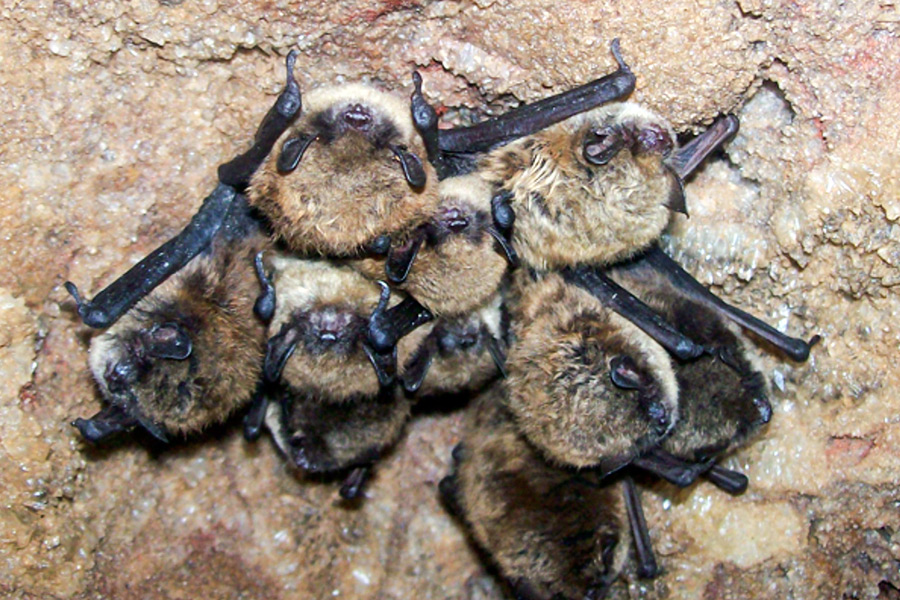Bats to the Future?
As a westward-spreading fungal infection decimates bat populations across the nation, prompting federal wildlife officials to propose listing another species as endangered, Glacier Park researchers step up efforts to monitor the winged mammals
By Tristan Scott
Since its inception in 2010, biologists in Glacier National Park have been working to expand the park’s bat inventory and monitoring program, girding against the likely arrival of a westward-spreading fungal disease that has decimated bat populations across North America.
Last week, those efforts gained a new urgency when the U.S. Fish and Wildlife Service (FWS) announced a proposal to reclassify the northern long-eared bat as endangered under the Endangered Species Act. Currently listed as threatened, the federal agency wrote that the northern long-eared bat “faces extinction due to the range-wide impacts of white-nose syndrome, a deadly disease affecting cave-dwelling bats across the continent.”
Bats are critical to healthy, functioning ecosystems and contribute at least $3 billion annually to the U.S. agriculture economy through pest control and pollination, the federal agency wrote in its listing proposal. The growing “extinction crisis” highlights the importance of the ESA and efforts to conserve species before declines become irreversible, the agency explained.
“White-nose syndrome is devastating northern long-eared bats at unprecedented rates, as indicated by this science-based finding,” FWS Regional Director Charlie Wooley said. “The Service is deeply committed to continuing our vital research with partners on reducing the impacts of white-nose syndrome, while working with diverse stakeholders to conserve the northern long-eared bat and reduce impacts to landowners.”
Researchers in Glacier grasped the vitality of that research years ago, when biologist Lisa Bate marshaled scarce resources, including a grant from the nonprofit Glacier Park Conservancy, and enlisted a team of partners, collaborators and volunteers to assess bat species in the park. The researchers used acoustic monitoring and mist-netting to confirm the presence of bats “overwintering” in buildings and caves, while gaining a better understanding of bat migration paths and timing.
Bate hopes the years-long effort to investigate the habits of bats in Glacier will help provide baseline data prior to the likely arrival in the park of white-nose syndrome, the spread of which has caused bat populations to plummet in the eastern United States while giving a new urgency to bat conservation in the West.
“As the disease continues to spread, the national parks in its path have stepped up their efforts to learn about and protect native bat populations,” said Bate, whose work has led to the discovery of three new bat species in Glacier.
Since beginning surveys in 2011, the research has confirmed the presence of nine bat species in Glacier Park — the little brown, long-eared, long-legged, big brown, eastern red, silver-haired, and hoary bats, as well as California and Yuma myotis — but not the northern long-eared bat.
“Our detections of the eastern red bat, and the California and Yuma myotis, allowed us to add three new species to Glacier’s mammals list,” Bate wrote of the research. “These detections also expanded the known range for each of these species … The long-eared was the second-most commonly found bat, followed by the hoary bat. The first time we saw and heard a hoary bat, we felt like biologists exploring in a remote country and discovering a new species unknown to the world. We had no idea that such a beautiful animal had been flying over our heads all our lives. None of us in Glacier had ever seen one. Their beautiful coats, large size, and unique hissing and clicking sounds made every mosquito bite we had endured worth it, as this creature was new to us all.”
Although Montana is included in the federal agency’s range description for northern long-eared bats, it’s still unknown if they reside, hibernate in or migrate through Glacier National Park, Bate said. However, researchers have confirmed the presence of the eastern red bat, a species that was not expected to reside in Glacier, and Bate wonders if there could be other anomalies as well.
According to Bate, white-nose syndrome is likely to appear in Glacier by 2026, so the effort to gain a better understanding of the park’s resident bats has become a race against the clock.
“Documenting the exact range occupied by a threatened species is critical to its conservation,” she said. “Species at the edge of their range may be more capable of adapting to climate change and other stressors like white-nose syndrome.”
White-nose syndrome has spread across nearly 80% of the northern long-eared species’ North American range and nearly all of its U.S. range since it was listed as threatened in 2015. According to federal officials, the proposal to change the status of the northern long-eared bat comes after an in-depth review of the species found the bat continues to decline and now meets the definition of endangered under the ESA.
To date, Bate has analyzed more than 70,000 bat call recordings from the park, although the poor recording quality has limited the number of definitive classifications. Diagnostic echolocation calls for northern long-eared bats require the use of hardware that can record calls above 100 kHz, and two of the park’s detectors are not capable of recording above that decibal threshold.
However, with a grant received in 2016 from the NPS Natural Resource Stewardship and Science Directorate’s Biological Resources Division, Bate has been able to replace the two obsolete detectors with high-quality instruments and microphones to survey for this species.
“This new equipment is now providing higher-quality acoustic data on the presence, activity, migration, and hibernation patterns of all bat species in the park that are at risk from white-nose syndrome,” she wrote.